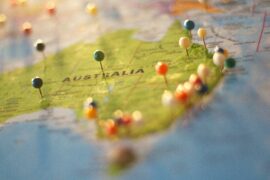Contents
Was Australia Colonized?
Australia’s history is a tapestry woven with threads of complexity and controversy. At the heart of this narrative lies the question: was Australia truly colonized? To unravel this intricate tale, we must journey back to a time before European arrival, where the land down under was inhabited by diverse Indigenous peoples, each with their own rich cultures and traditions.
Pre-Colonial Australia: A Land of Diversity and Tradition
Long before the arrival of Europeans, Australia was home to a mosaic of Indigenous cultures. From the Aboriginal peoples of the mainland to the Torres Strait Islanders, these communities thrived in harmony with the land, forging deep connections rooted in spirituality and kinship. The Dreamtime stories whispered through generations, weaving together the fabric of Australia’s ancient past.
Indigenous Societies and Connections to the Land
Indigenous Australians were not merely inhabitants of the land; they were custodians, with a profound spiritual connection to their ancestral territories. For example, the Noongar people of Western Australia have a deep spiritual connection to the land, known as “Country,” which forms the basis of their cultural identity and worldview.
Pre-Contact Societies: Traditions and Customs
Before the arrival of Europeans, Indigenous societies flourished across Australia, each with its own unique customs and social structures. For instance, the Yolngu people of Arnhem Land in the Northern Territory have a rich cultural heritage that encompasses intricate kinship systems, complex ceremonies, and profound connections to the land and sea.
European Exploration and Early Contact: The Dawn of a New Era
The 17th and 18th centuries saw the emergence of European explorers venturing into the unknown waters of the Southern Hemisphere. Dutch navigators skirted the western coast, while the famed Captain James Cook charted the eastern seaboard, forever altering the course of history.
Arrival of European Explorers: A New World Beckons
Driven by a thirst for discovery and the promise of riches, European explorers set sail for the distant shores of Australia. In 1606, Dutch navigator Willem Janszoon became the first recorded European to set foot on Australian soil, laying claim to the land in the name of the Dutch East India Company. Similarly, Captain James Cook’s voyage aboard the HMS Endeavour in 1770 led to the first recorded European contact with the eastern coast of Australia.
Impact of Early Contact: Encounters and Exchanges
The arrival of Europeans heralded a new chapter in Australia’s history, marked by initial encounters with Indigenous peoples. These interactions ranged from friendly exchanges to violent clashes, as cultural misunderstandings and competing interests collided on the frontier. For instance, the encounter between Captain Cook and the Indigenous peoples of Botany Bay in 1770 resulted in both curiosity and conflict, as the two cultures grappled with their differences and misunderstandings.
British Colonization: The Sun Never Sets on the British Empire
In 1788, the British flag was raised on the shores of Botany Bay, marking the beginning of British colonization in Australia. The establishment of convict colonies laid the foundation for European settlement, as waves of migrants arrived on distant shores in search of a new life.
Establishment of Convict Colonies: A Penal Experiment
The British government saw Australia as an opportunity to alleviate overcrowding in its prisons, leading to the establishment of convict colonies in New South Wales and beyond. These early settlements were built on the backs of convict labor, shaping the landscape and society of colonial Australia. For example, the penal colony of Port Arthur in Tasmania became notorious for its harsh conditions and treatment of convicts, leaving a lasting imprint on Australia’s colonial history.
Terra Nullius Doctrine: The Myth of Empty Lands
Central to British colonization was the concept of terra nullius, or “land belonging to no one.” This legal fiction denied the existence of Indigenous sovereignty, paving the way for the wholesale dispossession of Aboriginal and Torres Strait Islander peoples from their traditional lands. The ramifications of this doctrine are still felt today, as Indigenous communities continue to fight for recognition of their land rights and sovereignty.
Indigenous Resistance and Conflict: The Frontier Wars
The colonization of Australia was not without resistance. As European settlers encroached further into Indigenous territories, conflict erupted on the frontier, leaving a trail of violence and displacement in its wake.
Frontier Violence: Clashes and Consequences
The frontier wars were characterized by sporadic outbreaks of violence between settlers and Indigenous peoples, fueled by competing interests over land and resources. These conflicts often resulted in devastating consequences for Indigenous communities, as traditional ways of life were disrupted and dispossessed. For example, the Hawkesbury and Nepean Wars in the early 19th century saw intense conflict between British settlers and Indigenous tribes in the Sydney region, resulting in widespread casualties and displacement.
Impact of Disease and Dispossession: A Legacy of Loss
The arrival of Europeans brought with it a wave of disease that decimated Indigenous populations across Australia. Coupled with forced removal from their lands, Indigenous communities faced unparalleled challenges in the wake of colonization, leading to profound and lasting impacts on their cultures and identities. Diseases such as smallpox, measles, and influenza spread rapidly among Indigenous populations, resulting in catastrophic loss of life and cultural upheaval.
Assimilation Policies and Stolen Generations: A Dark Chapter in Australia’s History
In the 20th century, the Australian government pursued policies of assimilation aimed at eradicating Indigenous cultures and identities. Central to this agenda was the forced removal of Indigenous children from their families, a practice that would have far-reaching consequences for generations to come.
Assimilation Policies: The Erasure of Identity
Under the guise of “civilizing” Indigenous peoples, the Australian government implemented policies aimed at assimilating them into mainstream society. These policies sought to strip Indigenous communities of their cultural heritage and language, leaving a legacy of trauma and loss that continues to reverberate today. For example, the Aboriginal Protection Act of 1909 in Victoria gave the government sweeping powers to control the lives of Indigenous peoples, including the forcible removal of children from their families.
Stolen Generations: The Human Cost of Assimilation
Perhaps the most egregious example of assimilation policies was the forced removal of Indigenous children from their families. These children, known as the Stolen Generations, were forcibly placed in institutions or adopted by non-Indigenous families, resulting in the loss of culture, identity, and connection to country. The stories of the Stolen Generations are a painful reminder of the injustices perpetrated against Indigenous peoples in the name of assimilation.
Indigenous Rights Movements: Resilience and Resistance
Despite centuries of oppression, Indigenous peoples have continued to fight for their rights and recognition. From grassroots activism to landmark legal battles, the struggle for justice and equality remains ongoing in Australia today.
Emergence of Indigenous Activism: Voices of Change
The latter half of the 20th century saw a resurgence of Indigenous activism, as communities mobilized to demand recognition of their rights and sovereignty. Organizations such as the Aboriginal Tent Embassy and the Land Rights movement became powerful symbols of resistance and resilience. For example, the 1967 referendum, which saw an overwhelming majority of Australians vote to include Indigenous peoples in the census and give the federal government power to legislate for them, marked a turning point in the recognition of Indigenous rights.
Land Rights Struggles: Fighting for Sovereignty
Central to Indigenous rights movements has been the fight for land rights and self-determination. The landmark Mabo decision in 1992 overturned the doctrine of terra nullius, paving the way for Native Title claims and the recognition of Indigenous sovereignty over traditional lands. This decision was a watershed moment in Australian legal history, affirming the rights of Indigenous peoples to their ancestral lands and laying the groundwork for future land rights negotiations.
As Australia grapples with the legacy of its colonial past, efforts towards reconciliation and healing have gained momentum in recent years. Through dialogue, education, and acknowledgment of past injustices, there is hope for a future built on mutual respect and understanding.
National Sorry Day: Acknowledging the Past
National Sorry Day, observed annually on May 26th, serves as a day of reflection and remembrance for the Stolen Generations and the injustices they endured. It is a time for all Australians to come together and acknowledge the wrongs of the past, paving the way for reconciliation and healing. For example, the National Apology delivered by then-Prime Minister Kevin Rudd in 2008 was a significant step towards healing the wounds of the past and building a more inclusive and equitable future.
Challenges and Ongoing Struggles: The Road Ahead
While progress has been made towards reconciliation, significant challenges remain. Gaps in health, education, and socioeconomic outcomes persist between Indigenous and non-Indigenous Australians, highlighting the ongoing legacy of colonization and the need for continued action and advocacy. For example, the Closing the Gap initiative, launched in 2008, aims to address disparities in life expectancy, health, education, and employment between Indigenous and non-Indigenous Australians, but progress has been slow, underscoring the need for sustained efforts to achieve meaningful change.
Conclusion: Reflecting on Australia’s Colonial Legacy
In conclusion, the question of whether Australia was truly colonized is not a simple one. While the arrival of Europeans undoubtedly brought profound changes to the continent, it is essential to recognize the resilience and resistance of Indigenous peoples in the face of colonization’s devastating impacts.
As Australia continues on its journey towards reconciliation, it is imperative that we confront the truths of our past, acknowledge the ongoing injustices faced by Indigenous communities, and work together towards a future founded on respect, equality, and shared prosperity. Only then can we truly reckon with the legacy of Australia’s colonial history and forge a path towards healing and reconciliation for all Australians.
So, was Australia truly colonized? The answer lies not only in the history books but in the ongoing struggles and resilience of Indigenous peoples across the continent. As we navigate the complexities of our shared past, let us strive to build a future that honors the voices and experiences of all Australians, past, present, and future.





